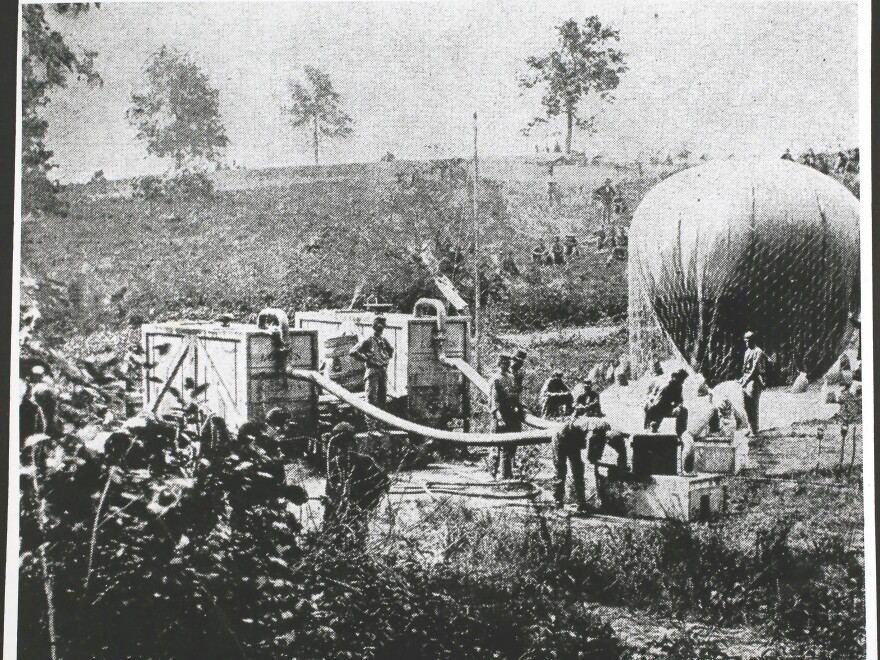The U.S. government is increasingly convinced that an alleged Chinese spy balloon was thousands of miles off of its intended course.
An official, speaking on condition of anonymity on Thursday, told NPR that the government now suspects the spy balloon was supposed to surveil Guam and Hawaii, but ended up flying over Alaska, Canada and eventually, the rest of the continental United States.
According to the official, the probable cause of the course deviation was one of the oldest foes faced by military balloons: the wind.
The balloon was first spotted by the public over Montana on Feb. 1. The U.S. military tracked it as it drifted across the country before an F-22 Raptor brought it down with an air-to-air missile three days later. China has maintained that it was an "unmanned civilian airship."
If the balloon's path really was a mistake, then the incident is just the latest in a long line of errant military balloons, which for over two centuries have been blown hither and thither by everything from breezes to gales
Generals have been put at risk, diplomatic relations strained, and millions of dollars of sensitive equipment ruined. And despite it all, nations just don't seem to be able to let go of their balloons.
Zeppelin vs. Zephyr
The love affair with balloons started long before airplanes took flight. As early as 1794, the French army operated balloons during the Battle of Fleurus in combat against the Austrians. During the American Civil War, President Abraham Lincoln created the U.S. Army Balloon Corps to surveil the enemy.
When you're fighting a war, perspective matters, says Tom D. Crouch, an emeritus curator at the Smithsonian's National Air and Space Museum. "In military terms, it's always good to be able to get up high to see as much as you can behind the enemy lines," he says.

But for as long as there have been balloons, the wind has had something to say about where they fly. On April 11, 1862, during the siege of Yorktown, Virginia, a balloon carrying a Union general named Fitz John Porter came untethered and began drifting towards the Confederate position. Marksmen took a few potshots at the bobbing general as he floated over the enemy, Crouch says. "Fortunately, the winds shifted, and they were blown back over the Union lines."
Balloons continued to see regular use in conflicts through World War I, but it was nearly a century later, in the mid-1950s, that the U.S. government undertook a far more ambitious balloon surveillance project.
New, lightweight materials, such as mylar, allowed researchers to build balloons that could travel high into the stratosphere, near the edge of space. That technology, together with electronics and remote cameras meant that uncrewed balloons could potentially drift across enemy territory, providing views that, at the time, were unavailable any other way.
And the U.S. had one enemy in particular it wanted to watch: the Soviet Union.
"You would take special cameras, attach them to high-altitude balloons, set them adrift in Western Europe and let them drift over the Soviet Union," says Stephen Schwartz, a non-resident senior fellow at the Bulletin of the Atomic Scientists.

The goal, Schwartz says, was to fly over the vast Soviet homeland and collect intelligence on nuclear weapons. "We were terrified that the Soviet Union was going to unleash a surprise attack and we didn't know what they were really capable of, so any useful information would have been helpful," he says.
The culmination of these efforts was a top-secret program called Project Genetrix. Starting in January of 1956, the U.S. government began releasing dozens of high-altitude balloons from airbases in Germany and Turkey.
But it didn't last long.
"It was essentially a disaster," Schwartz says. And once again, the wind was to blame: "You had no idea where the balloons were going, so it was just hit or miss as to what you would see."
Genetrix balloons captured images of enormous tracts of Soviet farmland. And clouds. Lots of clouds.
Also, balloons are really easy to shoot down
In addition to being haphazard, the Genetrix balloons weren't very stealthy either, says Tom Crouch. U.S. intelligence "hoped that they could get by without the Soviets noticing," he says. "That didn't happen."
Within a month, Soviet air defenses were taking down balloons left and right. "They just shot them out of the sky," Crouch says. "They had big public exhibitions in Moscow of these balloon camera systems that the nefarious Americans were sending over the innocent Soviets."
The Air Force briefly tried to solve the problems with still more balloons. "They launched them in very large numbers, hoping that a significant number would get through," Crouch says.
What did they think they were going to get with a balloon?
In total, around 500 balloons were released, but the strategy quickly became unsustainable. In February, just barely a month after Project Genetrix began, the Soviets went public, protesting what they called "a gross violation of Soviet airspace." The once-top secret program was on the front page of the New York Times.
At the same time, Crouch says, the CIA was close to deploying a spy plane known as the U-2. The highly classified plane was capable of flying at altitudes far above normal aircraft, but not above the balloons. The intelligence agency became concerned that the balloons were drawing undue attention to that patch of the sky.

"They were worried that the Soviets were going to be so good at shooting things down and looking for things that the U-2 program would be compromised," he says.
In the end, President Dwight D. Eisenhower decided that the balloon program wasn't worth the headaches, and Project Genetrix ended almost as quickly as it began.
Can't Let Go
And yet, despite all the ups and downs, interest in surveillance balloons is still going strong. In July of last year, Politico reported that the Pentagon was looking at using surveillance balloons to again spy on China and Russia. The report says budget documents show it intends to spend $27.1 million this fiscal year to study the possibility.

But it's clear that the wind isn't backing down either. In addition to possibly having a hand in this latest diplomatic bust-up, it's been sabotaging other efforts. In 2015, a Pentagon surveillance balloon being tested at the Aberdeen Proving Grounds came unmoored and drifted into Pennsylvania, before coming down in a thicket of woods. Critics say the program cost the government more than $2 billion before it floated away.
Crouch, the retired historian, says he's watched the latest events with China's balloon unfold with a mix of bemusement and bewilderment.
It's now an age where satellites, planes, drones and cell phone cameras can give virtual views of almost any spot on the Earth.
"For heaven's sake," he asks, "what did they think they were going to get with a balloon?"
NPR's Greg Myre contributed to this report. contributed to this story
Copyright 2024 NPR. To see more, visit https://www.npr.org.




